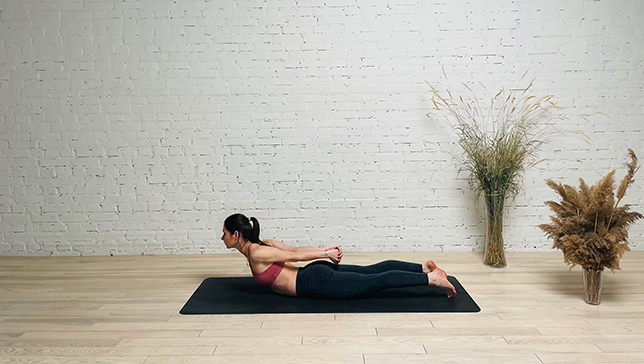Snake Pose - Sarpasana

Contents
Snake Pose or Sarpasana (sar-PAH-sah-nah) is derived from two Sanskrit terms ‘sarpam’, which means snake, and ‘asana’ which means posture. The physical body in this posture is a close resemblance of a snake, hence the name.
Snake Pose unlike Cobra Pose (Bhujangasana), is an unsupported backbend, making it a challenging one for the core (abs) and lower back. This prone practice initially may seem hard on the back and lower abdomen, but with intelligent use of the pelvis, psoas, chest, and gluteus, the torso can be lifted to go gently in a backbend. The use of the arms with the engaging of the triceps and biceps keeps the body stable and in balance. In addition, the arms and shoulders help open the chest keeping the breathing process deep and slow, thereby supporting the body to remain stable, balancing on the upper thighs and pelvis.
Pose Detail
- By Type: Chest Opening Yoga Poses, Strengthening Yoga Poses
- Difficulty: Intermediate
- Body Position: Prone Yoga Poses, Supine Yoga Poses
Step-by-Step Instructions
Benefits and Contraindications
Opens the chest and lungs
Gently stretches the shoulders
Strengthens the back
Improves posture
Stomach ulcer
Hernia
High blood pressure
Photo poses in different angles

Modifications, Props and Tips
- Beginners due to a stiffened shoulder might be having difficulty in grasping the hand behind the body. So, by grabbing a rope or strap in a clasped fist, one can reach each other or by sliding the fist to the middle. However, regular practice gradually releases the stiffness from the shoulder.
- Weak core muscles and lack of spinal flexibility make it harder to lift off the torso from the floor. So, beginners can rest their torso against the wall and can turn their head to either side with hands beside the waist. This will establish flexibility in the spine and stretch the core as well.
- Practitioners find difficulty in keeping the final pose due to pressure on the abdomen. It makes snake pose uncomfortable in breathing. They place a pillow or bolster under their floating ribs. This will distribute the weight of the torso on the entire props and assist in breathing during the practice.